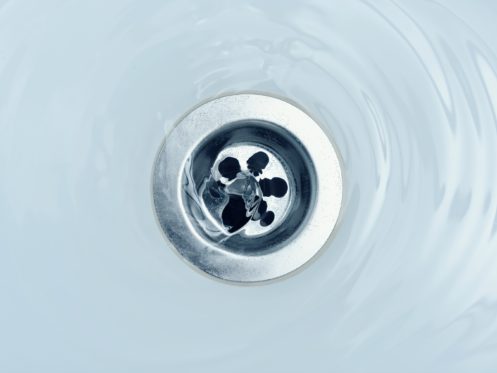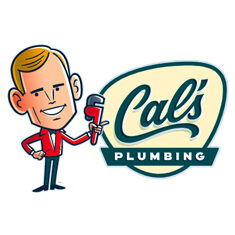All plumbing systems eventually become clogged; there is no way to avoid this. And so, when your plumbing does become clogged, you need to have the best knowledge and tips at hand to unclog it.
This post will demonstrate how to unclog a bathtub, kitchen sink, floor drain, and toilet drain. These tried-and-true methods will unclog practically any obstruction. However, if you can’t clear a blockage after several attempts, it is best if you consider hiring a drain-cleaning service or certified plumber. Note that excessive force might cause irreparable damage to a fixture or pipe.
Here are 10 simple DIY techniques for unclogging a drain in your home’s plumbing system:
- Use a twisted wire hanger to fish out debris near the drain opening, avoiding pushing clogs deeper.
- Pour dishwashing detergent and boiling water to dissolve hair or grease clogs, followed by plunging for better results.
- Combine baking soda and vinegar for a fizzy reaction to break down minor clogs, then flush with hot water after an hour.
- Opt for washing soda (sodium carbonate) as a stronger alternative to baking soda for stubborn blockages.
- Use a wet/dry vacuum on liquid mode to suction out clogs, ensuring a tight seal over the drain.
- Pour Coca-Cola down drains to dissolve obstructions with its acidity, but rinse thoroughly to avoid sticky residue.
- Remove and clean the P-trap under sinks to physically clear trapped debris, using a bucket to catch water.
- Plunge drains with proper technique, using sink-specific plungers and ensuring airtight seals for maximum suction.
- Avoid DIY drain snakes/augers if inexperienced, as improper use risks pipe damage; call professionals for tough clogs.
- Handle caustic soda (sodium hydroxide) cautiously with protective gear, mixing it with cold water before flushing with boiling water.
1. A Twisted Wire Hanger
As dirt, skin, hair, and food particles adhere to the scum, which builds up on the walls of your drainpipes, they can quickly clog your drains. This will eventually reduce water flow.
A simple hanger may clear a clogged sink effectively. Straighten out a standard coat hanger and fashion a little hook at one side of the wire. Slowly insert this end into the drain and begin to “fish” out the debris. Avoid pushing it lower, as this could cause the obstruction to go deeper down the drain. Instead, use hooking or prodding motions to help loosen and remove the clog.
2. Dish Washing Detergent
Hair readily clogs shower drains. With toilets, its typically feces, excess toilet paper, napkins, female sanitary goods, and cotton balls. Other than human waste, you should place all other items in a trash bin.
Dish detergent is a perfect option for these areas because it eliminates residue, soaks up, and lubricates the drain. Pour a cup of dishwashing liquid and then boiling water into the gutter. Use a plunger to assist with unclogging it. You may also don rubber gloves and remove the obstruction with your hands.
3. Vinegar and Baking Soda
This mixture is not only cool for your seventh-grade volcano; its fizzing strength can also assist in removing minor clogs, such as those in your wash basin.
Start by pouring boiling water into your drain and wait for it to clear. Then pour approximately a half cup of baking soda. After about five minutes, run a combination of boiling water and one cup of white vinegar into the drain. Allow this mixture to work its magic for about one hour (however, the longer it sits, the greater the benefit)
Then, use the hot faucet to drain the water and see whether it is draining properly.
4. If Baking Soda Is Ineffective, Use Washing Soda
If baking soda does not work and you want a stronger DIY option, washing soda is the next best option.
Sodium carbonate, sometimes known as washing soda, is a common item in cleaning household goods and an excellent do-it-yourself drain unclogging ingredient. Its alkalinity is higher than baking soda’s and is thus a more effective drain cleaner.
Pour boiling water and washing soda down the drain of your sink. Then, add a cup of hot water and wait five minutes. This should assist in clearing any obstructions. If your sink continues to drain slowly, repeat the step.
Pro tip: If you don’t have washing soda, pour a half-inch of baking soda into a roasting tin or baking dish, and bake it for one hour at 400 degrees Fahrenheit. This will result in the discharge of excess carbon dioxide and the formation of washing soda.
5. Make Use of a Wet/Dry Vacuum
A wet/dry vacuum performs precisely what its name implies: it removes liquid, dried dust, and debris. These pieces of equipment are frequently used to remove waste from clogged drains, particularly if the blockage is located high up.
Before you start, construct a seal over the utility hole to avoid creating a mess; an old plunger head works nicely for this. Then, switch the vacuum cleaner to the liquid setting with the strongest suction and position it over the plughole’s opening. Switch on your vacuum and let it run for one to two minutes. Then, turn it off and run the water slowly to determine if the sink is unobstructed.
6. Coke
You perhaps have Coke in your refrigerator now. Pour a 1.5-liter bottle of Coke, Pepsi, or an equivalent generic brand down the obstructed drain.
Although it is far gentler than professional drain cleaners, Coca-Cola is quite acidic and excellent at removing clogs from drains. Allow it to sit for no less than one hour before using hot water to flush it away.
It’s worth mentioning that Coke is the best remedy for stubborn clogs. Because of their acidity, carbonated beverages effectively remove filth from pipes. Nevertheless, they can leave behind a gummy residue since they have sugar syrup. And so, use a different approach, such as washing soda or baking soda, if you are simply dealing with a little sink clog.
7. Purge the P-Trap
If the vinegar or baking soda methods fail to unclog your drain, you may need to eliminate the obstruction physically. The good thing is that you can clear the p-trap yourself, so there’s no need to look for expert services.
The p-trap is a bowed or rounded pipe beneath your sink, which collects debris and prevents it from entering your house’s plumbing system.
Place a bucket beneath your sink to collect any excess water and remove the u-shaped conduit (the p-trap) beneath your sink with a plier or wrench. Empty your p-trap and place it in another sink to wash and clean any debris.
8. Plungers
If none of the above solutions work, try using a plunger to clear your drain. If you’re dealing with a smaller drainage issue, like in your shower or sink, you’ll need a different plunger than if you’re dealing with a toilet.
Use your plunger to create an extremely tight seal. Plunge the drain using force and then run water to see if it’s still blocked.
9. Millipedes, Augers, and Snakes
Although millipedes and snakes are sold at almost every hardware store, they can damage or puncture your pipes if not used correctly. If you’re a newbie to plumbing, it’s best to hire Cal’s Plumbing to unclog more problematic clogs.
10. Caustic Soda
Because it can produce chemical burns, caustic soda is more severe than natural alternatives. It is also known as sodium hydroxide and necessitates using eye protection gear as well as rubber gloves. When working with this ingredient, be cautious and ensure the environment is adequately ventilated.
Add three cups of the ingredient to a three-quarters liter of chilled water in a tin. With a wooden spoon, thoroughly mix everything. When it starts fizzing, pour it down your blocked drain and wait 20 to 30 minutes. Then, pour boiling water down your drain to flush the mixture out. Repeat this procedure if your drain is substantially plugged.
If you’re looking to unclog your drains in Tucson, AZ, call Cal’s Plumbing to get started. Our team of experts provides top-notch plumbing, water heater, and water treatment services to our esteemed clients. We will inspect your plumbing and provide viable and cost-effective recommendations. Call Cal’s Plumbing today for more information.





